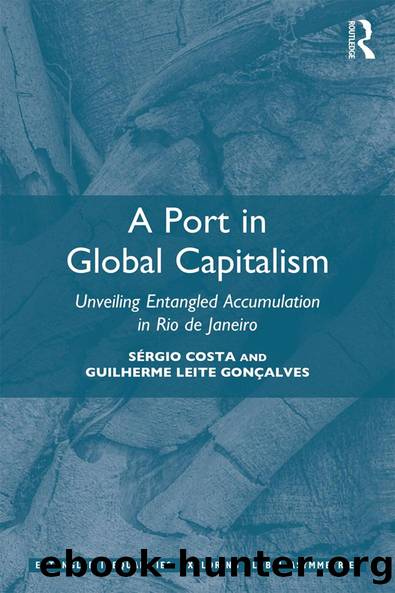A Port in Global Capitalism by Sérgio Costa Guilherme Leite Gonçalves

Author:Sérgio Costa, Guilherme Leite Gonçalves [Sérgio Costa, Guilherme Leite Gonçalves]
Language: eng
Format: epub
Tags: Social Science, General, Gerontology, Sociology
ISBN: 9781000709544
Google: MAW5DwAAQBAJ
Publisher: Routledge
Published: 2019-10-28T04:59:09+00:00
After the federal bureaucracy left, the city of Rio de Janeiro reshaped its own weight in the state economy by reaffirming its function as a provider of modern services, while the Baixada Fluminense (Fluminense Lowland) would reinforce its legacy with the consolidation of metal-mechanical and petrochemical industries.
(Oliveira and Rodrigues, 2009: 135)
Little Africa
The transformations observed in the forms of occupation and use of the port district accompany a more general shift in the new functions that the city has assumed as well as those that it has lost since the end of the 19th century. In the second half of the 19th century, the city was growing and becoming denser in areas removed from the port, while the port district was continually losing commercial value. This devaluation came to a head after the abolition of the slave trade, which brought with it the closure of the market and the cemetery. Along with economic deceleration, the zones adjacent to the port, particularly in the highest areas, the hills of Providência and Pinto, came to be occupied more and more by emancipated and later free blacks. One significant occupation of these hills came with the arrival of the combatants from the War of Canudos, a conflict between the federal government and a messianic movement located in the interior of Bahia, in 1897.1 When the federal government did not keep its promise to provide housing for the ex-combatants in Rio de Janeiro, they occupied the Hill of Providência and renamed it Hill of Favela in allusion to the hill next to the city of Canudos and the common shrub in the Bahian hinterlands called faveleira. Thus, the favela was born âfrom which all others take their nameâ (Cardoso, 2015: 187).
With the abolition of slavery in 1888 and the subsequent significant influx of migrants mainly from the Northeast of Brazil, the port district began solidifying its position as a residential area for the poor who lived with precarious infrastructure and only basic sanitation.2 Dubbed âLittle Africaâ by the composer and visual artist Heitor dos Prazeres (1898â1966), the area became a centre of Afrodescendent population and culture, in particular beginning around the end of the 19th century (Moura, 1995).3 After 1888, âLittle Africaâ, which had been occupied especially by freedmen during slavery, received hundreds of former slaves who became free after abolition. Accordingly, âLittle Africaâ transformed into a dynamic space of production of Afro-Brazilian culture, though it was seen with disdain by the elite concerned with reproducing high European culture.
The hills surrounding the port district â with âLittle Africaâ, their nucleus of political and cultural articulation â remained the place where the main popular revolts of early 20th-century Brazil were sparked: the Vaccine Revolt and the Revolt of the Lash. The first embodied the resistance to the hygienist policies that led to the destruction of tenement houses and the continual endeavours to remove the poor and black population from the centre of the city (Chalhoub, 1996; Pereira, 2002). The second symbolised the struggle against slaveholding mentality
Download
This site does not store any files on its server. We only index and link to content provided by other sites. Please contact the content providers to delete copyright contents if any and email us, we'll remove relevant links or contents immediately.
Cecilia; Or, Memoirs of an Heiress — Volume 1 by Fanny Burney(32442)
Cecilia; Or, Memoirs of an Heiress — Volume 2 by Fanny Burney(31875)
Cecilia; Or, Memoirs of an Heiress — Volume 3 by Fanny Burney(31858)
The Great Music City by Andrea Baker(31548)
We're Going to Need More Wine by Gabrielle Union(18974)
All the Missing Girls by Megan Miranda(15600)
Pimp by Iceberg Slim(14401)
Bombshells: Glamour Girls of a Lifetime by Sullivan Steve(13981)
Talking to Strangers by Malcolm Gladwell(13235)
Norse Mythology by Gaiman Neil(13219)
Fifty Shades Freed by E L James(13164)
For the Love of Europe by Rick Steves(13136)
Mindhunter: Inside the FBI's Elite Serial Crime Unit by John E. Douglas & Mark Olshaker(9214)
Crazy Rich Asians by Kevin Kwan(9174)
The Lost Art of Listening by Michael P. Nichols(7412)
Enlightenment Now: The Case for Reason, Science, Humanism, and Progress by Steven Pinker(7243)
The Four Agreements by Don Miguel Ruiz(6641)
Bad Blood by John Carreyrou(6559)
Weapons of Math Destruction by Cathy O'Neil(6152)
